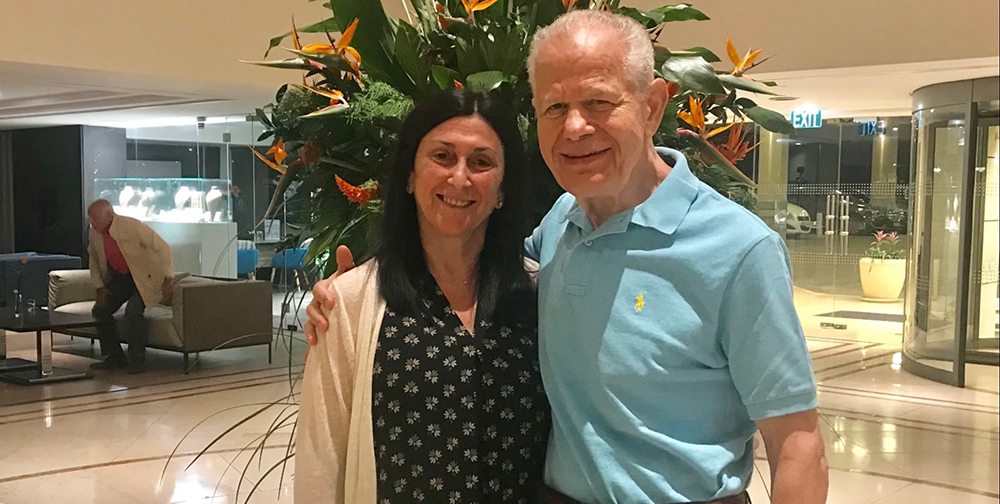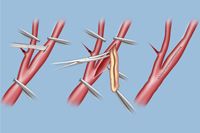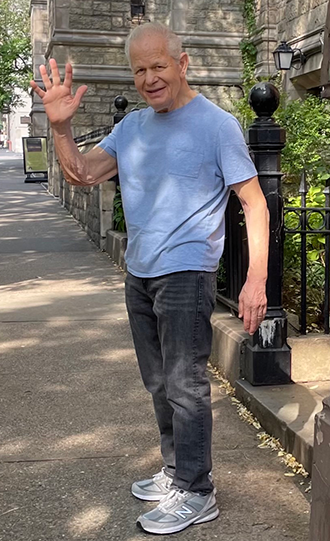
Some folks like to sit back and put their feet up in retirement, but not Jack Weinberg. Weinberg and his wife of 31 years, Nancy, stay very active – some days walking four miles from their Upper East Side home down to Chinatown, a stroll of more than 80 blocks. “We love Manhattan for those long, long walks,” says Jack, a retired lawyer, now 82. “We also love going to the opera, classical concerts, and restaurants. Before the Covid 19 pandemic restrictions, we used to go several times a year and intend to resume those activities as pandemic restrictions are eased. Nancy and I are each other’s best friend and enjoy spending a lot of time together.”
One morning, as Jack and Nancy were in the hallway outside their apartment with their small dog, something unusual happened. “I saw a gray cloud come out of nowhere over my right eye,” Jack recalls. “I called my primary care provider, Dr. Samuel Mann, who’s over at Weill Cornell. He told me to get to the ER right away. It did feel like an emergency room situation.” Dr. Mann’s recommendation connected Jack with Dr. Jared Knopman at NewYork-Presbyterian/Weill Cornell Medical Center, whose surgical skills helped ensure that Jack would have more long walks ahead with his wife.
“The gray film Jack saw is a potential symptom for patients experiencing significant carotid narrowing,” says Dr. Knopman. “Carotid occlusion, as you can tell from the name, is related to the carotid arteries located on both sides of the neck. It’s where you typically place your fingers to find a pulse. Above that point, the carotid artery branches into two smaller vessels, one of which goes to the brain. When the pathway that leads to the brain is blocked or narrowed by plaque, pieces of plaque can spontaneously break off, which can lead to retinal hypoxia, thus the temporary loss of vision. Symptoms like this may resolve, but if they’re left ignored, they can lead to a significant subsequent stroke.”

In a carotid endarterectomy, the blood flow is temporarily clamped off, then a vertical slit is made in the blocked artery. After the blockage is removed, neurosurgeons reconstruct the vessel wall and close up the artery.
Thankfully, the emergency department at NewYork-Presbyterian/Weill Cornell Medical Center was only a few blocks from home, and the couple walked over there together. “As we walked to the hospital, the gray film that blocked my right eye cleared up,” Jack says. “When we got there, they ran all kinds of tests to see if I’d suffered a stroke.”
Dr. Knopman explained the test results to Jack: His right carotid artery was almost completely blocked and it would have to be surgically cleared. “I was stunned,” recalls Jack. “I’d been diligent in watching my diet, and every annual test showed my cholesterol levels to be in normal range. But after speaking with Dr. Knopman, I learned that it all came down to genetics. My diet might have delayed it, but it was genetics that betrayed me in the end.”
It wasn’t his family’s first brush with an arterial blockage. Jack remembered his father’s being in a similar situation more than 30 years ago. “My father underwent a balloon angioplasty in 1985,” he says. “When my father had that procedure done, a piece of plaque broke off and he suffered a stroke. That experience, coupled with Dr. Knopman’s advice and his team’s guidance, helped me make the decision of going with a carotid endarterectomy.”
“When it comes to carotid occlusion, we have several options to treat the patient,” says Dr. Knopman. “Balloon angioplasties and stents, like Jack’s father had, are one option — and rest assured, that technology has come a long way since 1985! But because of the nature and anatomy of Jack’s carotid artery, my neurology colleague Dr. Mir and I recommended a carotid endarterectomy. That’s an open surgical procedure that tackles the problem at its core by removing the blockage itself. We start by making a small cut in the neck, then carefully open the carotid artery and remove the blockage. We finish up by reconstructing the artery wall.”
Jack felt confident with what lay ahead. “With Dr. Knopman in my corner, I felt at ease,” he says. “He was patient, personable, and he explained things very carefully. My wife was with me and he allowed us both any questions we had. The answers he gave made us feel very comfortable.”
The surgery was scheduled for just a few days later, and Dr. Knopman recommended that Jack spend those days at home rather than in the hospital. “Whenever possible, and if the patient’s condition allows, it can help to rest at home and mentally prepare for the surgery,” Dr. Knopman says.
On the day of the surgery, Jack took a short walk from home over to the hospital. “The whole process was uneventful,” he recalls. “I was heavily sedated throughout the surgery, and I woke up in the recovery room. A short time later, Dr. Knopman visited — he said he thought the surgery went very well.”

Just three days after his carotid endarterectomy, Jack was back out walking.
“It ended up being a routine procedure,” says Dr. Knopman. “We have many years of track record performing carotid endarterectomies with excellent outcomes, but we don’t just choose a treatment because we’re experienced at it. Behind each surgical recommendation are numerous evaluations and nuances, which help inform our choice of a treatment specifically tailored for that individual patient.”
After the surgery, Jack’s recovery was quick — he only needed one night in the hospital. “It was amazing!” Jack says. “Once they checked me in the morning, I was free to go home. Dr. Knopman told me to take it easy for a couple months, that any strenuous activity would affect the blood flow, but other than that I did fine.”
On a routine follow-up six months later, Dr. Knopman showed Jack a clean sonogram of his carotid artery. “It was good news,” Jack says. “I’m back to exercising the way I used to. My wife and I are back to going on walks, going to dinners, socializing with family and friends, and traveling. I’m just grateful to Dr. Knopman and everyone who helped me through this. And if anyone else is in my position, do your best to get him as your surgeon!”
More about Carotid occlusive disease
More about Dr. Jared Knopman